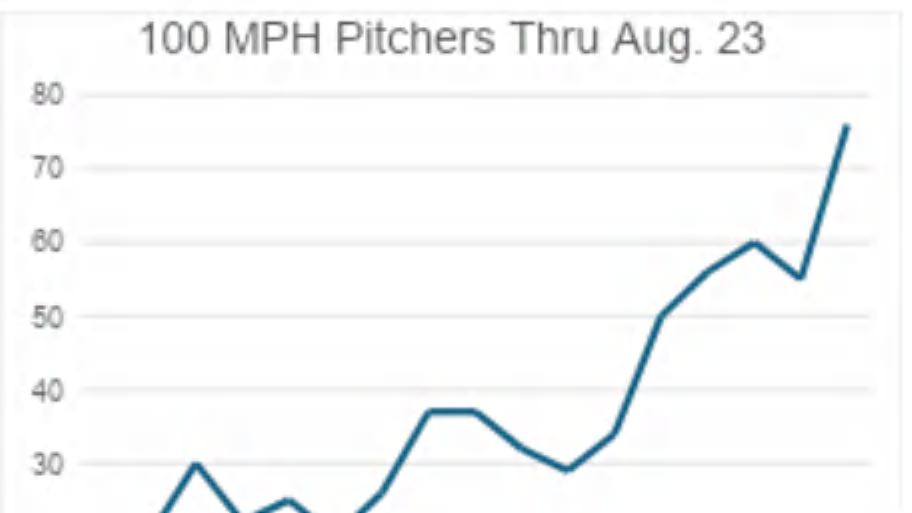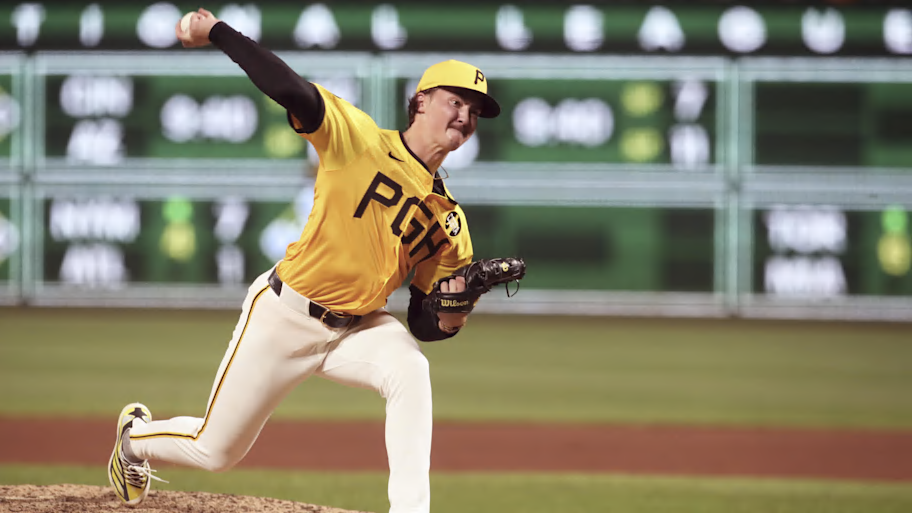Another week, and there are another three initiates of the 100-mph club. Zach “Big Sugar” Maxwell, 24, of the Reds, made his debut at 275 pounds and with an average fastball velocity of 100.7 mph. Joel Peguero, 28, averaged 101.1 mph for the Giants, and Bubba Chandler, 22, twice hit 100 mph in his debut for the Pirates.
Bubba Chandler registered TWO strikeouts at 100 MPH in his Major League debut 🔥 pic.twitter.com/2IUm53HUhb
— MLB (@MLB) August 23, 2025
You might think such big-arm pitchers were can’t-miss amateurs. But the universe of 100-mph throwers has expanded so far that Maxwell was a sixth-round pick, Peguero is pitching for his fifth organization in 10 years after signing his first pro contract and Chandler was a third-round pick.
With 20% of the season left to play, already we’ve seen more pitchers hit 100 mph (76) than in any complete season in baseball history (the record was 64 in 2022 and ’23).
This is the first generation of pitchers who have grown up under Velocity Inc., a catchall to describe the growth business of leveraging technology to teach velocity throughout the amateur market (colleges, private coaches, throwing labs, etc).
Compared to the same date of previous seasons, the number of pitchers who have hit 100 mph in the major leagues is up 38% from last year and 124% from 2019, the last full season before the velocity revolution began on the other side of the COVID-19-impacted campaign.
From 2008 to ’19, the 100-mph club held relatively steady, with gradual increases. But you can see the classic “hockey stick” growth pattern since ’21, including the huge spike this year:

With so many high-octane throwers, it might be easy to dismiss Chandler as just another player who pitches at 100 mph. Didn’t we just see Chase Burns light up the radar gun for the Reds? He also posted a 5.24 ERA before landing on the IL with a flexor tendon strain. (Burns is set to resume throwing this week.)
Chandler is different. He has the best starting-pitcher arm to come along since his Pittsburgh teammate Paul Skenes, who made his debut last season. Chandler made his entry out of the bullpen, but make no mistake, he’s a true starter. Pirates GM Ben Cherington said Chandler “could earn” starts in “September or whenever.” He should be in the rotation now. Keep him on his routine (83 of his 89 games in the minors were as a starter) and let him learn the major league prep work when you know you’re facing a lineup in five or six days.
What makes Chandler special is that you don’t see starting pitchers with a fastball like his. It is elite in terms of velocity and induced vertical break, a fancy way of measuring how well a fastball fights gravity with its spin. A high IVB, or vert, means the baseball doesn’t drop as much as the hitter expects.
Chandler is one of only nine pitchers with a four-seam fastball that averages 98-plus mph with 17-plus inches of vert. Burns is the only other starting pitcher in that group.
What makes Chandler even more frightening for hitters is that he has the second-lowest release point of those elite-velocity, elite-vert pitchers. Chandler is 6' 3" but uses his legs so well and has such a low arm slot that his vert is even more troublesome for hitters. His Vertical Attack Angle is nasty—low release to a high point in the zone with elite carry. Burns, who is also 6' 3", throws from a high, over-the-top slot that is 7 1/3 inches higher than Chandler’s slot, which can create more stress on the shoulder.
Here are the most elite fastballs in MLB as measured by velocity and vert. I added the vertical release point so you can see how Chandler comes at it from a different angle.
Four-Seam fastballs 98-plus MPH with 17-plus inch induced vertical break
*Starting pitchers
Like Skenes and Jacob deGrom, one of his pitching models, Chandler was a two-way player and terrific athlete (he switch-hits and is ambidextrous enough to have played first base and pitched one inning in high school left-handed) who only recently took to pitching full-time. He threw 92 mph as a high school junior, after which he chased velocity by packing on pounds as a senior. It paid off. He sat at 95 mph and touched 98 mph.
Chandler lasted until the third round in 2021 because he appeared headed to Clemson to play quarterback. The Pirates gave him $3 million to sign, a massive sum for a third-rounder, in part because they saved slot money on No. 1 pick, catcher Henry Davis. Chandler hit .186 in his first two pro seasons before giving up the idea of being the next Shohei Ohtani.
A generation ago, coaches harangued young pitchers toget your arm up. With his athleticism, elite velocity and low arm slot, Chandler is a proxy for state of the art pitching—though he didn’t get there by being a pitcher-only since 10 years old, a mistake made by many in the velocity generation.
Pitchers are throwing harder and from a lower release point. As we saw with 100-mph throwers, the numbers below held relatively steady until 2021, when the effects of Velocity Inc. really kicked in:
MLB four-seam fastballs
Pitching evolves. It always has and always will. Some pitchers accelerate the evolution because they do something so well and so unique that others want to copy them. In the wild-card era, five pitchers stand out as the biggest influencers. In order of how they changed the game:
Skenes is the primo influencer now because, layered atop velocity and a low arm slot, he shapes a menu of pitches to exploit hitters’ weaknesses, whether they are right-handed or left-handed. In his most recent start, for example, Skenes threw seven pitches (two fastballs, two off-speed, three breaking) at 15 different mph increments from 80 to 100 mph. He has Martínez’s multi-pitch intellect, Halladay’s command and deGrom’s velocity and arm slot.
It’s too much to ask Chandler to be the next great pitching influencer. But in one, narrow way, he and Burns are signaling what’s next: athletic starting pitchers with high-velocity, high-spin fastballs that once belonged almost exclusively to closers. More will follow.
More MLB on Sports Illustrated
This article was originally published on www.si.com as Why Pirates’ Bubba Chandler’s 100-MPH Arm Is Different From the Rest.
